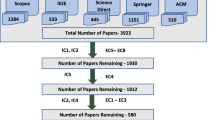Abstract
Weighted sequential pattern mining has recently been discussed in the field of data mining. Different from traditional sequential pattern mining, this kind of mining considers different significances of items in real applications, such as cost or profit. Most of the related studies adopt the maximum weighted upper-bound model to find weighted sequential patterns, but they generate a large number of unpromising candidate subsequences. In this study, we thus propose an efficient approach for finding weighted sequential patterns from sequence databases. In particular, a tightening strategy in the proposed approach is proposed to obtain more accurate weighted upper-bounds for subsequences in mining. Through the experimental evaluation, the results also show the proposed approach has good performance in terms of pruning effectiveness and execution efficiency.




Similar content being viewed by others
References
Agrawal R, Srikant R (1994) Fast algorithm for mining association rules. In: Proceedings of the international conference on very large data bases, pp 487–499
Agrawal R, Srikant R (1995) Mining sequential patterns. In: Proceedings of the ieee international conference on data engineering, pp 3–14
Agrawal R, Srikant R, Vu Q (1997) Mining association rules with item constraints. In: Proceedings of the 3rd international conference on knowledge discovery in databases and data mining, pp 66–73
Agrawal R, Imielinksi T, Swami A (1993) Mining association rules between sets of items in large database. In: Proceedings of The ACM SIGMOD international conference on management of data, pp 207–216
Agrawal R, Imielinski T, Swami A (1993) Database mining: a performance perspective. IEEE Trans Knowl Data Eng 5(6):914–925
Ahmed CF, Tanbeer SK, Jeong BS (2010) A novel approach for mining high-utility sequential patterns in sequence databases. ETRI J 32(5):676–686
Ahmed CF, Tanbeer SK, Jeong BS (2009) Efficient mining of weighted frequent patterns over data streams. In: Proceedings of IEEE international conference on high performance computing and communications (HPCC), pp 400–406
Ahmed CF, Tanbeer SK, Jeong BS, Lee YK (2008) Handling dynamic weights in weighted frequent pattern mining. Inst Electr Inf Commun Eng (IEICE) 91-D(11):2578–2588
Ahmed CF, Tanbeer SK, Jeong BS, Lee YK, Choi HJ (2012) Single-pass incremental and interactive mining for weighted frequent patterns. Expert Syst Appl 39(9):7976–7994
Chang JH (2011) Mining weighted sequential patterns in a sequence database with a time-interval weight. Knowl Based Syst 24(1):1–9
Frequent itemset mining implementations repository, Available at http://fimi.cs.helsinki.fi/
IBM Quest Data Mining Project, Quest Synthetic Data Generation Code, Available at http://www.almaden.ibm.com/cs/quest/syndata.html
Le B, Nguyen H, Vo B (2010) Efficient algorithms for mining frequent weighted itemsets from weighted items databases. In: Proceedings of international conference on computing & communication technologies, research, innovation, and vision for the future (RIVF), pp 1–6
Liu Y, Liao W, Choudhary A (2005) A fast high utility itemsets mining algorithm. In: Proceedings of the utility-based data mining workshop, pp 90–99
Pei J, Han J, Asi BM, Wang J, Chen Q (2004) Mining sequential patterns by pattern-growth: the prefixspan approach. IEEE Trans Knowl Data Eng 16(11):1424–1440
Shie BE, Yu PS, Tseng VS (2013) Mining interesting user behavior patterns in mobile commerce environments. Appl Intell 38(3):418–435
Song W, Liu Y, Li J (2014) Mining high utility itemsets by dynamically pruning the tree structure. Appl Intell 40(1):29–43
Srikant R, Agrawal R (1996) Mining sequential patterns: generalizations and performance improvements. In: Proceedings of the 5th international conference extending database technology, pp 3–17
Yen SJ, Lee YS (2013) Mining non-redundant time-gap sequential patterns. Appl Intell 39(4):727–738
Yun U, Leggett JJ (2005) WFIM: weighted frequent itemset mining with a weight range and a minimum weight. In: Proceedings of the 5th SIAM international conference on data mining, pp 636–640
Yun U, Leggett JJ (2006) WSpan: weighted sequential pattern mining in large sequence databases. In: Proceedings of the 3rd international ieee conference on intelligent systems, pp 512–517
Yun U (2008) A new framework for detecting weighted sequential patterns in large sequence databases. Knowl Based Syst 21(2):110–122
Yun U (2009) On pushing weight constraints deeply into frequent itemset mining. Intell Data Anal 13(3):359–383
Author information
Authors and Affiliations
Corresponding author
Rights and permissions
About this article
Cite this article
Lan, GC., Hong, TP. & Lee, HY. An efficient approach for finding weighted sequential patterns from sequence databases. Appl Intell 41, 439–452 (2014). https://doi.org/10.1007/s10489-014-0530-4
Published:
Issue Date:
DOI: https://doi.org/10.1007/s10489-014-0530-4




